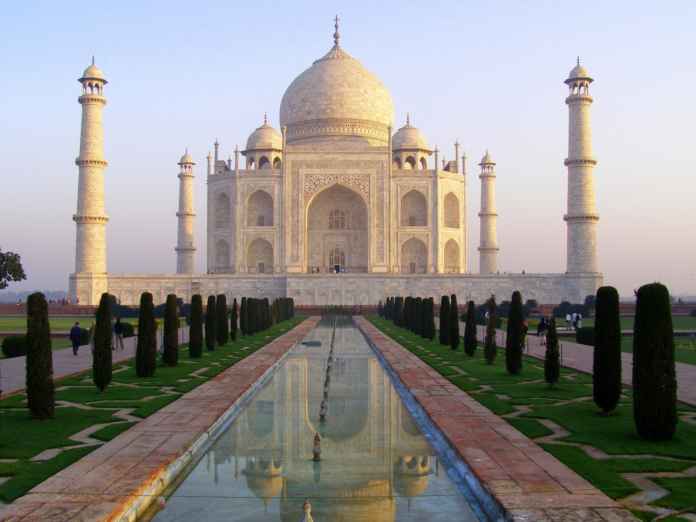Every Indian you talk to will take immense pride in talking about the Taj Mahal, the dazzling white mausoleum constructed by Shah Jahan in the loving memory of his wife Mumtaz Mahal. India’s’ Nobel Laureate, Rabindra Nath Tagore, referred to the Taj Mahal as a “tear drop on the cheek of time” and rightly so.Regarded by many as the finest example of Mughal architecture, the construction of the Taj Mahal began in 1632, after Shah Jahan was grief stricken with the death of his wife Mumtaz Mahal after the birth of their 14th child. The universal appeal of Taj Mahal is unparalleled, a testament being the fact that it was declared a UNESCO World Heritage Site in 1983 and also that the site attracts approximately 3 million tourists annually.
Taj Mahal combines elements from Persian, Ottoman Turkish and Indian architectural styles. Ustad-Ahmad Lahori is credited for being the main architect of the Taj Mahal. This elegant structure, which took 22 years for completion also happens to be one of the most well preserved and architecturally beautiful tomb in the world.
Located on the right bank of the Yamuna River, the complex in which this monument is located is spread over 17 hectares. This land originally belonged to the Kachhwahas of Ajmer from whom it was acquired in lieu of four havelis. As many as 28 different varieties of semi-precious and precious stones were used to adorn the Taj. The white marble for external use was obtained from Makrana in Rajasthan.
Throughout the complex, passages from the Qur’an are used as decorative elements. These passages were chosen by a Persian calligrapher Abd ul- Haq to whom Shah Jahan gave him the title of “Amanat Khan”. The texts chosen refer broadly to themes of judgment. These subtelties reveal itself only on closer examination of the interiors.
In terms of structure, the tomb, which attracts the immediate focus of the viewer, is the representation of the house of the queen in Paradise. It also houses the cenotaphs of Mumtaz Mahal and Shah Jahan. Shah Jahan intended to build a ‘Black Taj’, in black marble opposite the present mausoleum, but due to the war with his sons interrupted couldn’t complete it. Ultimately, he was buried next to the love of his life in the Taj. Further outwards, four minarets frame the tomb, one at each corner of the plinth. The marble dome that surmounts the tomb is the most spectacular feature.
According to legends, during his eight years long ailment and imprisonment by Aurangzeb, Shah Jahan would view The Taj lying on the bed through a diamond fixed in the wall in front at a particular angle.
Behind the beauty of the Taj Mahal, the epitome of love, also lies a gory side. As per sources, Emperor Shah Jahan ordered that every worker’s hands be chopped off immediately after construction, so that no one could ever recreate the Taj Mahal.
Visitors should note that Taj Mahal remains closed on Fridays. This is because the Taj Mahal has a mosque within its premises. However, those going for customary prayers are permitted. Tickets on all other days are available at Eastern, Southern and Western gate for Rs 20 for Indians.
Once you visit Taj, you’ll realise that the English poet, Sir Edwin Arnold has rightly described The Taj Mahal as “Not a piece of architecture, as other buildings are, but the proud passions of an emperor’s love wrought in living stones.”










